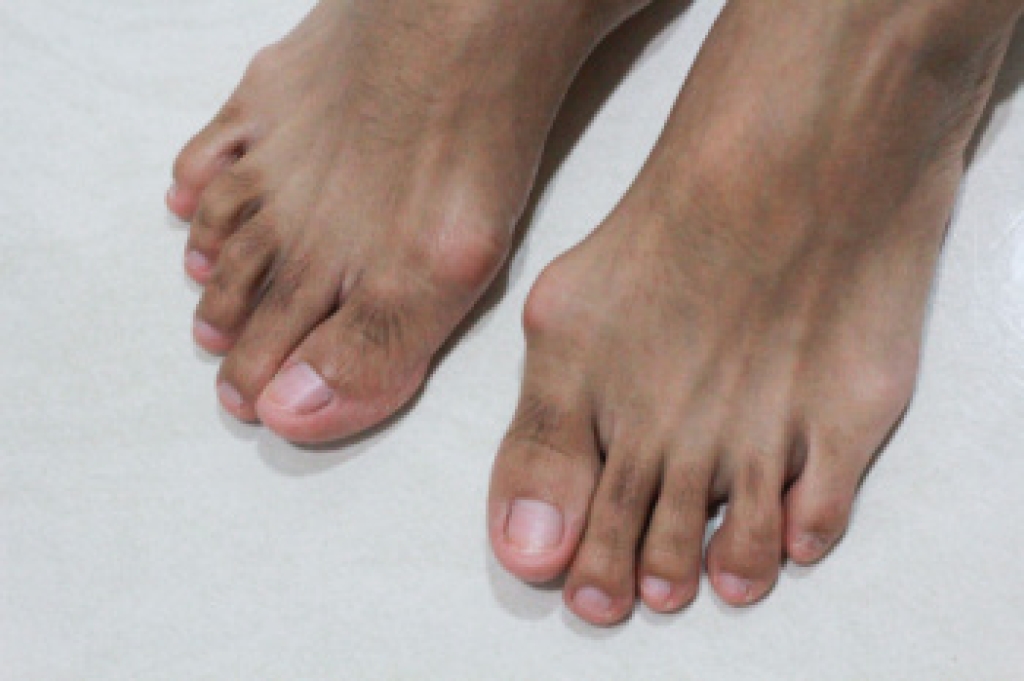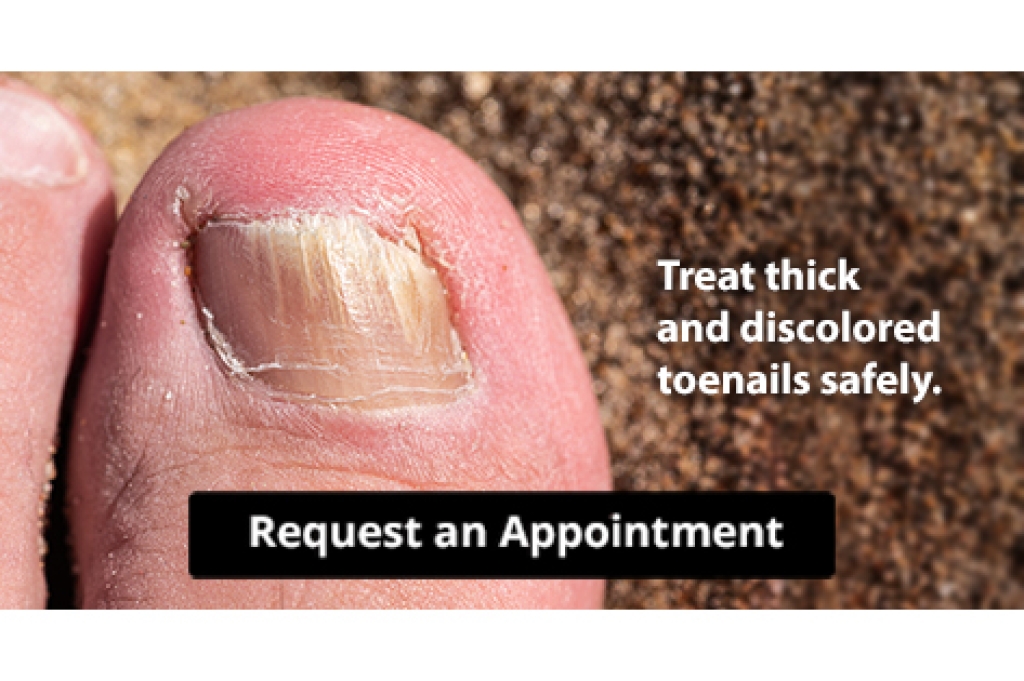Blog
When Bunions Become More Than a Bump

Bunions are a common foot deformity that appears as a bony bump at the base of the big toe. They often develop due to genetics, flat feet, arthritis, or prolonged wearing of tight or narrow shoes. Symptoms include swelling, stiffness, and pain that worsens with walking or shoe pressure. As the big toe begins to lean toward the second toe, the base of the toe pushes outward causing a deformity. In mild cases, a podiatrist can help with conservative treatments, such as padding, custom orthotics, footwear modifications, and anti-inflammatory medications. However, when pain becomes constant, mobility is limited, or if the bunion interferes with daily activities, surgery may be necessary to realign the bones and relieve discomfort. A podiatrist will evaluate the severity of the bunion through a physical exam and X-rays and determine whether surgery is needed. It is suggested that you schedule an appointment with a podiatrist if a bunion is causing ongoing pain or difficulty with wearing footwear.
If you are suffering from bunion pain, contact Mindy J. Trotter, DPM, CWSP of Georgia. Our doctor can provide the care you need to keep you pain-free and on your feet.
What Is a Bunion?
Bunions are painful bony bumps that usually develop on the inside of the foot at the joint of the big toe. As the deformity increases over time, it may become painful to walk and wear shoes. Women are more likely to exacerbate existing bunions since they often wear tight, narrow shoes that shift their toes together. Bunion pain can be relieved by wearing wider shoes with enough room for the toes.
Causes
- Genetics – some people inherit feet that are more prone to bunion development
- Inflammatory Conditions - rheumatoid arthritis and polio may cause bunion development
Symptoms
- Redness and inflammation
- Pain and tenderness
- Callus or corns on the bump
- Restricted motion in the big toe
In order to diagnose your bunion, your podiatrist may ask about your medical history, symptoms, and general health. Your doctor might also order an x-ray to take a closer look at your feet. Nonsurgical treatment options include orthotics, padding, icing, changes in footwear, and medication. If nonsurgical treatments don’t alleviate your bunion pain, surgery may be necessary.
If you have any questions, please feel free to contact our office located in Peachtree City, GA . We offer the newest diagnostic and treatment technologies for all your foot care needs.
Understanding Athlete’s Foot in Men

Tinea pedis, commonly known as athlete’s foot, is a frequent problem among men, especially those who wear tight shoes or spend long hours in socks. This fungal infection thrives in warm, moist environments and often begins between the toes, causing itching, burning, peeling skin, and an unpleasant odor. If left untreated, it can spread to the toenails or other parts of the body. Good hygiene, wearing breathable footwear, and regular sock changes can help prevent recurrence. Persistent infections may require prescription-strength treatment. Avoiding shared locker rooms or showers barefoot also helps stop reinfection. For men who notice ongoing irritation or cracked, itchy skin between the toes, it is suggested that you visit a podiatrist to ensure an accurate diagnosis, and fast relief from this stubborn and uncomfortable condition.
Athlete’s foot is an inconvenient condition that can be easily reduced with the proper treatment. If you have any concerns about your feet and ankles, contact Mindy J. Trotter, DPM, CWSP from Georgia. Our doctor will treat your foot and ankle needs.
Athlete’s Foot: The Sole Story
Athlete's foot, also known as tinea pedis, can be an extremely contagious foot infection. It is commonly contracted in public changing areas and bathrooms, dormitory style living quarters, around locker rooms and public swimming pools, or anywhere your feet often come into contact with other people.
Solutions to Combat Athlete’s Foot
- Hydrate your feet by using lotion
- Exfoliate
- Buff off nails
- Use of anti-fungal products
- Examine your feet and visit your doctor if any suspicious blisters or cuts develop
Athlete’s foot can cause many irritating symptoms such as dry and flaking skin, itching, and redness. Some more severe symptoms can include bleeding and cracked skin, intense itching and burning, and even pain when walking. In the worst cases, Athlete’s foot can cause blistering as well. Speak to your podiatrist for a better understanding of the different causes of Athlete’s foot, as well as help in determining which treatment options are best for you.
If you have any questions please feel free to contact our office located in Peachtree City, GA . We offer the newest diagnostic and treatment technologies for all your foot and ankle needs.
Ankle Sprains in Volleyball

Ankle sprains are common in volleyball due to the quick and forceful movements involved in the sport. Actions such as spiking and blocking place significant stress on the ankle as players jump and land, sometimes on uneven surfaces or another player’s foot. Risk factors include reduced muscle strength, limited active range of motion, and poor balance or footwear that lacks support. Additionally, symptoms often include pain, swelling, bruising, and difficulty bearing weight. A podiatrist can help by diagnosing the severity of the sprain, providing bracing or orthotics, and recommending prevention strategies. If you have sustained an ankle sprain while playing volleyball, it is suggested that you promptly consult a podiatrist who can provide expert foot and ankle care.
Ankle and foot injuries are common among athletes and in many sports. They can be caused by several problems and may be potentially serious. If you are feeling pain or think you were injured in a sporting event or when exercising, consult with Mindy J. Trotter, DPM, CWSP from Georgia. Our doctor will assess your condition and provide you with quality foot and ankle treatment.
Common Injuries
The most common injuries that occur in sporting activities include:
- Achilles Tendonitis
- Achilles Tendon Rupture
- Ankle Sprains
- Broken Foot
- Plantar Fasciitis
- Stress Fractures
- Turf Toe
Symptoms
Symptoms vary depending upon the injury and in some cases, there may be no symptoms at all. However, in most cases, some form of symptom is experienced. Pain, aching, burning, bruising, tenderness, tightness or stiffness, sensation loss, difficulty moving, and swelling are the most common symptoms.
Treatment
Just as symptoms vary depending upon the injury, so do treatment options. A common treatment method is known as the RICE method. This method involves rest, applying ice, compression and elevating the afflicted foot or ankle. If the injury appears to be more serious, surgery might be required, such as arthroscopic or reconstructive surgery. Lastly, rehabilitation or therapy might be needed to gain full functionality in the afflicted area. Any discomfort experienced by an athlete must be evaluated by a licensed, reputable medical professional.
If you have any questions please contact our office located in Peachtree City, GA . We offer the newest diagnostic and treatment technologies for all your foot and ankle needs.
When Heel Pain Strikes

Plantar fasciitis is one of the most common causes of heel pain, resulting from inflammation of the plantar fascia, a thick band of tissue that connects the heel bone to the toes. This condition often develops due to overuse, wearing improper footwear, high arches, or prolonged standing. Symptoms include sharp or stabbing pain in the heel, especially during the first steps in the morning or after periods of rest. The pain may ease with movement, but often returns after long periods of standing or walking. A podiatrist can diagnose plantar fasciitis through a physical exam, medical history, and sometimes imaging to rule out other conditions. Treatment options may include stretching exercises, custom orthotics, night splints, or anti-inflammatory medications. Addressing the issue early can prevent chronic discomfort and long-term complications. If you are suffering from heel pain, it is suggested that you schedule an appointment with a podiatrist to receive an accurate diagnosis and personalized treatment plan.
Plantar fasciitis can be very painful and inconvenient. If you are experiencing heel pain or symptoms of plantar fasciitis, contact Mindy J. Trotter, DPM, CWSP from Georgia. Our doctor can provide the care you need to keep you pain-free and on your feet.
What Is Plantar Fasciitis?
Plantar fasciitis is the inflammation of the thick band of tissue that runs along the bottom of your foot, known as the plantar fascia, and causes mild to severe heel pain.
What Causes Plantar Fasciitis?
- Excessive running
- Non-supportive shoes
- Overpronation
- Repeated stretching and tearing of the plantar fascia
How Can It Be Treated?
- Conservative measures – anti-inflammatories, ice packs, stretching exercises, physical therapy, orthotic devices
- Shockwave therapy – sound waves are sent to the affected area to facilitate healing and are usually used for chronic cases of plantar fasciitis
- Surgery – usually only used as a last resort when all else fails. The plantar fascia can be surgically detached from the heel
While very treatable, plantar fasciitis is definitely not something that should be ignored. Especially in severe cases, speaking to your doctor right away is highly recommended to avoid complications and severe heel pain. Your podiatrist can work with you to provide the appropriate treatment options tailored to your condition.
If you have any questions, please feel free to contact our office located in Peachtree City, GA . We offer the newest diagnostic and treatment technologies for all your foot care needs.

